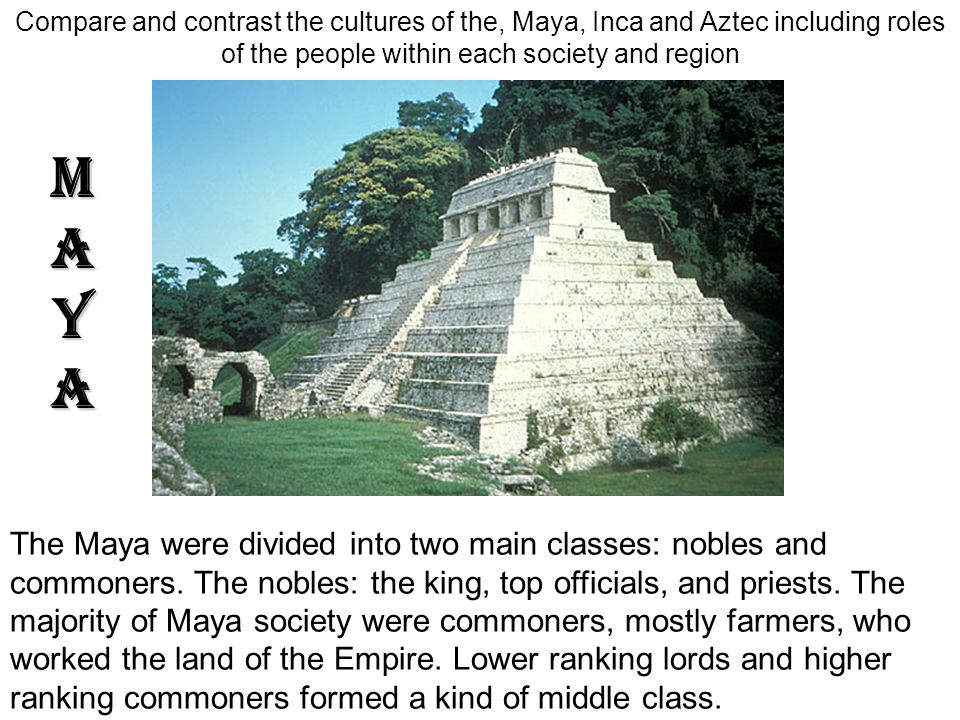The Mayans and the Aztecs were two of the most remarkable pre-Columbian civilizations that lived in Mesoamerica before the arrival of the Spanish. In terms of geography, the Mayans inhabited regions of Mexico, Guatemala, Belize, Honduras and El Salvador, while the Aztecs were located in the central plateau of Mexico. While both societies were hierarchical, the Mayans believed in the divine right of their rulers, while the Aztecs believed in the cyclical nature of the universe. Their economies were both based on agriculture and production, while their religions were polytheistic. Both societies made significant advancements in various fields, from engineering to astronomy.
The Mayans vs. The Aztecs: A Comparison of Two Pre-Columbian Civilizations
Introduction
The Mayans and the Aztecs were two of the greatest pre-Columbian civilizations that lived in Mesoamerica before the arrival of the Spanish conquistadors. They both had unique cultures, customs, languages and religious beliefs that continue to intrigue scholars and visitors to this day. In this article, we will compare and contrast the Mayan and Aztec civilizations in terms of their geography, societies, economies, religions, and achievements.
Geography
The Mayan civilization inhabited parts of present-day Mexico, Guatemala, Belize, Honduras, and El Salvador. The region was covered by dense jungles, swamps, and hills, which posed challenges to their agricultural practices. The Aztec civilization, on the other hand, was located in the central plateau of Mexico, a region with dry and arid land, which required sophisticated irrigation systems to support their crops.
Societies
The Mayan society was hierarchical, with nobles, priests, and rulers at the top, followed by artisans and merchants, and finally, farmers and laborers. They believed in the divine right of their rulers and practiced human sacrifices to appease their gods. The Aztec society was also hierarchical, with an emperor, noble families, soldiers, priests, and commoners. They believed in the cyclical nature of the universe and practiced war, tribute, and human sacrifices to maintain their cosmology.
Economies
The Mayan economy was based on agriculture, especially the cultivation of corn, beans, and squash, as well as the production of textiles, pottery, and jade. They also traded with other civilizations, such as the Olmecs, Teotihuacans, and Toltecs. The Aztec economy was based on tribute, which they collected from conquered territories, as well as agriculture, including the cultivation of corn, beans, and squash, and the production of textiles, pottery, and gold jewelry. They also had a sophisticated market system, known as the tianguis, which hosted traders from all over the empire.
Religions
The Mayan religion was polytheistic, with a pantheon of gods and goddesses who controlled various aspects of nature, society, and the afterlife. They built elaborate pyramids, temples, and palaces to honor their gods and performed various rituals and sacrifices to maintain their divine favor. The Aztec religion was also polytheistic, with a pantheon of gods and goddesses who controlled various aspects of nature, society, and the underworld. They built impressive temples, such as the Templo Mayor, to honor their gods and performed various rituals, including the famous human sacrifices, to sustain their cosmic balance.
Achievements
The Mayan civilization achieved remarkable advances in astronomy, mathematics, writing, art, and architecture. They developed a sophisticated calendar, which helped them predict astronomical events, such as eclipses and solstices. They also invented the concept of zero, which revolutionized mathematics, and created a hieroglyphic writing system, which recorded their history, myths, and religious beliefs. They produced beautiful artworks, such as jade carvings, murals, and pottery, that reflected their cosmology and daily life. They constructed impressive cities, such as Tikal, Palenque, and Chichen Itza, which featured monumental pyramids, plazas, and stelae.
The Aztec civilization achieved remarkable advances in engineering, agriculture, medicine, and ritual. They built impressive causeways, aqueducts, and canals, which connected their capital, Tenochtitlan, to the mainland and brought water and goods from other regions. They practiced innovative agricultural techniques, such as chinampas or floating gardens, which allowed them to grow crops in the shallow lake beds. They developed a sophisticated medical system, which incorporated herbal remedies, surgical procedures, and psychoactive plants. They also created a complex ritual calendar, which established their social and religious events, and integrated them into their daily life.
Conclusion
Overall, the Mayan and Aztec civilizations were two of the most fascinating and complex pre-Columbian societies that existed in Mesoamerica. They both had unique features, such as their geography, societies, economies, religions, and achievements, that have shaped their legacy and influenced the world. Although they faced various challenges, such as environmental, social, economic, and political factors, they thrived for centuries and left an impressive cultural heritage that we still admire today.
